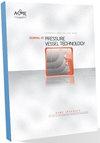Theoretical Analysis of Free Vibration and Transient Response of Rectangular Plate-Cavity System Under Impact Loading
IF 1.4
4区 工程技术
Q4 ENGINEERING, MECHANICAL
Journal of Pressure Vessel Technology-Transactions of the Asme
Pub Date : 2023-03-11
DOI:10.1115/1.4062121
引用次数: 0
Abstract
This paper presents a theoretical method to solve the free vibration and transient responses of a rectangular plate-cavity system. The spectral collocation method was used to solve the resonant frequencies and corresponding mode shapes of rectangular plates based on Kirchhoff thin-plate and Mindlin-Reissner thick plate theories. A linear velocity potential function was employed to model the fluid pressure applied to the plate surface. Unlike in previous studies, it was not assumed that the wet-mode shapes were the same as the dry-mode ones. Rather, the wet modes were assumed to be the superposition of the dry modes; then, the resonant frequencies and corresponding mode shapes of the wet modes could be obtained by solving the equations of the coupled system by exploiting the orthogonality of dry modes. Using dry modes' orthogonality and superposition of the wet modes, the transient responses of the rectangular plate-cavity system under impact loading can be solved. A method for estimating the resonant frequencies of the coupled system is proposed based on parametric studies to determine the influence of the fluid properties and plate materials on resonant frequencies. As a result, the resonant frequencies and transient responses obtained from the proposed theoretical methods are in excellent agreement with those obtained finite element analysis.冲击载荷作用下矩形板腔系统自由振动及瞬态响应的理论分析
本文提出了一种求解矩形板-腔系统自由振动和瞬态响应的理论方法。基于Kirchhoff薄板和Mindlin-Reissner厚板理论,采用谱配置法求解矩形板的谐振频率和相应的振型。采用线性速度势函数对施加在板表面的流体压力进行建模。与之前的研究不同,没有假设湿模形状与干模形状相同。相反,假设湿模式是干模式的叠加;然后,利用干模的正交性,通过求解耦合系统的方程,可以得到湿模的谐振频率和相应的振型。利用干模的正交性和湿模的叠加,可以求解矩形板-腔系统在冲击载荷作用下的瞬态响应。基于参数研究,提出了一种估计耦合系统谐振频率的方法,以确定流体性质和板材料对谐振频率的影响。因此,从所提出的理论方法获得的谐振频率和瞬态响应与有限元分析结果非常一致。
本文章由计算机程序翻译,如有差异,请以英文原文为准。
求助全文
约1分钟内获得全文
求助全文
来源期刊
CiteScore
2.10
自引率
10.00%
发文量
77
审稿时长
4.2 months
期刊介绍:
The Journal of Pressure Vessel Technology is the premier publication for the highest-quality research and interpretive reports on the design, analysis, materials, fabrication, construction, inspection, operation, and failure prevention of pressure vessels, piping, pipelines, power and heating boilers, heat exchangers, reaction vessels, pumps, valves, and other pressure and temperature-bearing components, as well as the nondestructive evaluation of critical components in mechanical engineering applications. Not only does the Journal cover all topics dealing with the design and analysis of pressure vessels, piping, and components, but it also contains discussions of their related codes and standards.
Applicable pressure technology areas of interest include: Dynamic and seismic analysis; Equipment qualification; Fabrication; Welding processes and integrity; Operation of vessels and piping; Fatigue and fracture prediction; Finite and boundary element methods; Fluid-structure interaction; High pressure engineering; Elevated temperature analysis and design; Inelastic analysis; Life extension; Lifeline earthquake engineering; PVP materials and their property databases; NDE; safety and reliability; Verification and qualification of software.

 求助内容:
求助内容: 应助结果提醒方式:
应助结果提醒方式:


